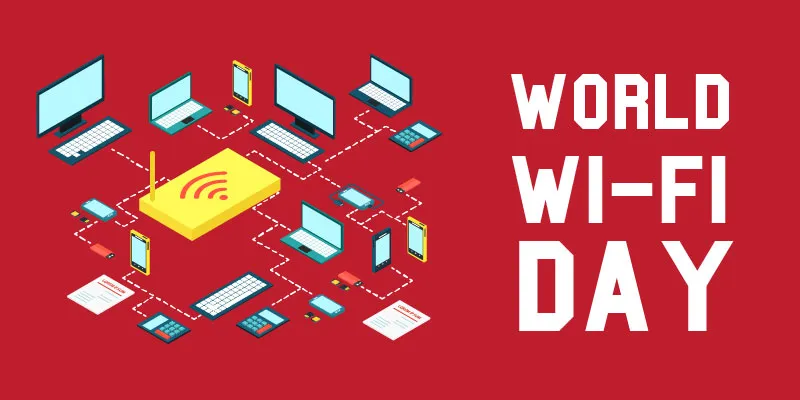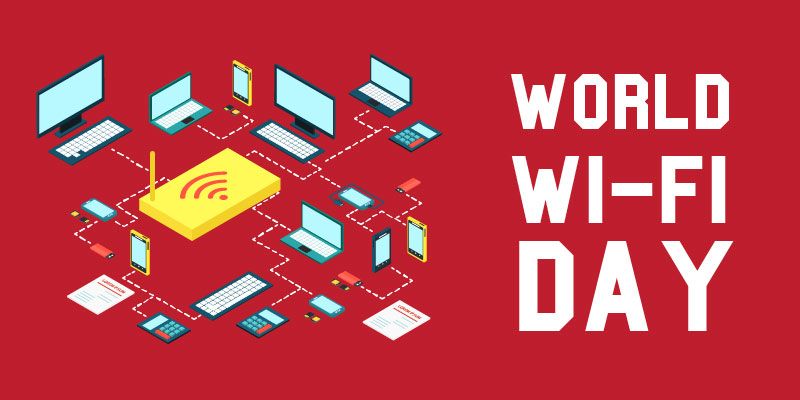This world Wi-Fi day, let the world celebrate together as one!
The advent of internet dates back to the year 1969. Known as ARPANET back then, it was one morning when Charley Kline at the University of California, Los Angeles (UCLA ) sent the first packets on ARPANET, in an attempt to connect to Stanford Research Institute. The first word he tried was ‘LOGIN’, but the system crashed when he reached the letter ‘G’. Not a fairy tale story, but that failure paved the way for the birth of internet.

Image Credits - FREEPIK
Fast forwarding 47 years, internet has not only become ubiquitous but also its just a click away. Unlike the conventional methods of wiring all computers to create a LAN, today Wi-Fi makes use of radio waves to transmit information. While we’re not far off from developing much more faster and powerful technologies to connect to the internet, for instance Li-Fi, let’s take a moment to celebrate 25 years of Wi-Fi (June 20, 2016) and appreciate how much comfort it has ushered into our lives.
While we might be at ease using Wi-Fi, how much do we actually know about it?
- The term Wi-Fi was coined by the brand-consulting firm Interbrand Corporation. Its technical designation is IEEE 802.11b. Having been handed with a serious job of naming a technology that’s going to revolutionise the forthcoming generations, the firm made a mockery out of it naming it as Wi-Fi, based on a pun, as it rhymed well with hi-fi, used for audio recording. Interbrand designed the logo of Wi-Fi as well.
- The symbol, which is highly familiar to all those who’ve used Wi-Fi-enabled devices, is a design symbolising a generic broadcast or antenna. The starting point represents the Wi-Fi source with the waves emanating from it signifying the strength of the signal.
- An integral part of the functioning of a Wi-Fi is the frequency hopping technology, which helps spreading its signal over rapidly changing frequencies. FHSS was invented by Hedy Lamarr, an Austrian and American film actress. FHSS was initially used in military technology, cordless phones, and now in wireless networks.
- The fastest wireless transmission speed ever achieved is through a 5G connection by researchers from the University of Surrey. The speed clocked was 1 terabit per second beating the previous record set by a 4G connection of 7.5 gigabits per second by 65,000 times.
- Having established and chaired the IEEE 802.11 Standards Working Group for WLAN led Vic Hayes being referred to as the “Father of Wi-Fi ”.
- Wi-Fi signals from your router are in general donut shaped.
- Ever compared the Wi-Fi speeds across different continents? Wi-Fi signals in the US are stronger than the ones in Europe, as the regulatory authorities in the US allow for higher transmission power, hence resulting in stronger signals.
- By 2018, 10 Gigabits per second (Gbps) speed Wi-Fi will be commercially available. Chinese telecom company Huawei hit those speeds in a laboratory research in 2016.
- By 2020, there will be 21 billion internet-connected devices across the globe.
- Some of the interesting internet-connected devices are walking sticks, umbrellas, baby car sensors, connected shirts, water bottles, tails, cutlery and the likes.
- Before being named Wi-Fi, there were a lot of tried and tested names for Wi-Fi like WaveLAN, FlankSpeed, DragonFly, WECA and IEEE802.11b Direct Sequence.
- A feature called dynamic rate scaling causes the strength of Wi-Fi signal to vary over distance.
- Even though people associate health hazards with the radio signals transporting data in Wi-Fi, it’s actually not harmful. The signals are of same frequency as microwave radiation, but the power is so less that there isn’t a noticeable heating effect, let alone the disruption of DNA. But it’s always advised to take precautions and cut down the time of our exposure with Wi-Fi-enabled devices.
- Wi-Fi is often referred to as 802.11 technology because it is based out of IEEE 802.11 standard. It has various sub-standards which are used for Wi-Fi connections:
- 11a - Makes use of high frequency, hence provides high speed. But, it cannot penetrate through walls.
- 11b - Slower than its previous counterpart ~ 11Mbps. It lacks range and can penetrate through walls.
- 11c - Not used for Wi-Fi connections.
- 11g - It’s the most commonly used sub-standard of Wi-Fi and its speed hovers around 54Mbps.
- 11n - It is speculated to be used in the near future and can provide speeds close to 150Mbps.
A flagship discovery of the 20th century, Wi-Fi changed the way the world accessed internet. Wi-Fi also made possible the transition, from being called the ‘wired’ era to be referred to as the ‘wireless’ era. In short, Wi-Fi just brought the world much closer than ever, metaphorically. Happy World Wi-Fi day!!!
(Disclaimer: The views and opinions expressed in this article are those of the author and do not necessarily reflect the views of YourStory.)






